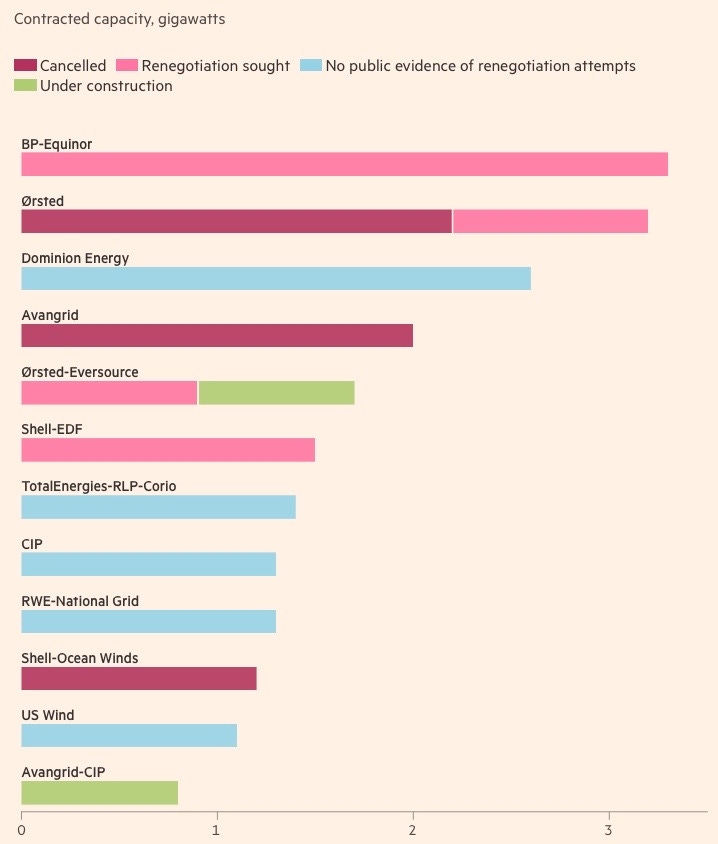Scuttled!
Offshore wind industry is "fundamentally broken," it's time to embarrass the guilty

Jessica Mitford was once dubbed the “Queen of the muckrakers.” A British aristocrat, she wrote two landmark books. The first was The American Way of Death, published in 1963, which exposed the abuses of the funeral industry. Three decades later, she published The American Way of Birth, which spotlighted the medical profession’s efforts to outlaw midwifery and increase profits for doctors and hospitals. One review called it “an indictment of the medical practices surrounding something that should not make us sick — giving birth.”
Mitford’s muckraking comes to mind as the massively hyped offshore wind industry collapses under the weight of higher interest rates, supply chain problems, and cost increases. The most recent evidence of the collapse came last week when the Danish company, Orsted, the world’s largest offshore wind developer, announced it was abandoning plans to build two huge wind projects offshore New Jersey with a total capacity of 2,000 megawatts.
I reported on the offshore wind sector’s woes last month in these pages, noting that “Avangrid, a subsidiary of the Spanish utility Iberdrola, announced that it was abandoning the 804-megawatt Park City Wind project offshore Connecticut because the project was ‘unfinanceable.’”
More than half of all U.S. offshore wind contracts, according to BloombergNEF, “have been terminated this year or at risk of being ended.” Among the losers: BP and Equinor, which wrote down the value of their offshore projects in New York by $840 million. The catastrophe led a BP executive to declare last week that “offshore wind in the U.S. is fundamentally broken.”

The offshore wind trainwreck brings to mind my favorite Mitford quote: “You may not be able to change the world, but at least you can embarrass the guilty.”
It’s time to embarrass the guilty. For years, the largest climate NGOs in America — with a willing assist from legacy media outlets — have been hyping offshore wind and claiming it is an essential part of our decarbonization efforts. Consider these quotes from a 2016 press release issued by Environment New York, which was published after then-New York governor Andrew Cuomo said he would push for offshore wind.
Kit Kennedy, Energy & Transportation Program Director at the Natural Resources Defense Council: “New York’s commitment to developing responsibly sited offshore wind is yet another commitment to the state’s climate and clean energy leadership. Governor Cuomo’s bold leadership is a vital step in helping the state meet its ‘50 by ’30’ clean energy goals, ensuring cleaner air and lower electricity systems costs for all New Yorkers.”
Catherine Bowes, Senior Manager at the National Wildlife Federation: “New Yorkers have much to celebrate with Governor Cuomo’s announcement that New York State will bring new, bold leadership in pursuit of offshore wind power. With a massive, untapped pollution-free energy source available right off our shores, we have no time to waste.”
Lisa Dix, Senior New York Representative of the Sierra Club: “We applaud Governor Cuomo’s announcement that the state will take a step in the right direction to seize the opportunity to move offshore wind forward, further building New York into an economic powerhouse fueled by renewable energy... Offshore wind has the potential to power millions of homes while creating tens of thousands of new jobs in the state, all while protecting our environment and coastal communities from the worsening impacts of climate disruption.”
Heather Leibowitz, Director for Environment New York said: “We look forward to working with state leaders and other stakeholders in the efforts to capture this immense pollution-free resource and move the Empire State to 100 percent renewable energy.”
In April 2021, when New York’s Indian Point nuclear plant was being prematurely shuttered, the NRDC’s Kennedy claimed the state didn’t need the nuclear plant because “New York continues to take bold action to install offshore wind.” In February 2022, Kennedy was on Twitter, hyping offshore wind:
Legacy media outlets also should be embarrassed. Few are guiltier of hyping offshore wind than National Public Radio. Ten months ago, NPR ran an article headlined, “Biden's offshore wind plan could create thousands of jobs, but challenges remain.” The article lauded President Joe Biden’s plan to install “30 gigawatts of offshore wind online by 2030” a move “that will require thousands of new jobs, especially in the construction sector. It's one of the reasons why President Biden often brings up the idea of new economic opportunities when he talks about tackling climate change.” The piece concluded with this bit of opinion, a line that could have been written by the NRDC: “With hundreds of square miles of untapped potential along American shores, offshore wind will grow exponentially in the coming years, and both American workers and the environment will benefit from it.”
Last week, after Orsted canceled its offshore wind project in New Jersey and said it would write off some $4 billion, NPR reported that the company’s “financial challenges mirror those facing the nascent industry.”
Nascent industry? Hardly.
As I wrote in Forbes in 2021, “Over the last two decades, numerous offshore projects, including the ill-fated 468-megawatt Cape Wind project, have been scuttled, delayed, blown off course, or abandoned.” Recall that in 2001, the backers of Cape Wind filed their first permit application. It would become one of the most contentious energy projects — of any kind — in US history. Cape Wind was officially deep-sixed in 2015.
The history of offshore wind is littered with failure and unfulfilled promises. In 2010, Google announced the Atlantic Wind Connection, an offshore transmission project that aimed to connect 6,000 megawatts of offshore wind capacity. Back then, Google said, “We believe in investing in projects that make good business sense and further the development of renewable energy.” Google (now Alphabet) and three other partners, including Marubeni Corporation, said they would spend $5 billion on the project. The project was quietly killed less than two years later.
In 2011, then-Interior Secretary Ken Salazar spoke at a conference sponsored by the American Wind Energy Association at which he declared, “From Texas to Oregon, to up and down the Atlantic Coast, there’s movement on offshore wind.” He continued, saying the Obama administration had set “an ambitious — but achievable — goal of deploying 10 gigawatts — that’s 10,000 megawatts — of offshore wind generating capacity by 2020, and 54 gigawatts by 2030.”
Today, a dozen years after Salazar’s pronouncement, the U.S. has exactly 42 megawatts of installed offshore wind capacity, or 9,958 megawatts short of the 2011 goal.
More offshore wind projects will be canceled in the coming months. Shortly after Orsted cancelled the New Jersey projects, the company also said it has suspended work on offshore projects in Maryland and Delaware.
These cancellations are great news for our whales, our oceans, fishermen, and ratepayers.
The only thing surprising about the collapse of the offshore wind industry — and the Biden administration’s plan to build 30 gigawatts of offshore capacity in less than a decade — is that anyone is surprised by this collapse. As I noted last month, the only thing dumber than onshore wind energy is offshore wind energy.
I will end by repeating a point I have been making for 15 years. We need a sober approach to decarbonizing our electric grid. If we are serious, we have to focus on energy sources that are low-carbon, mature, have high power density, and are scalable. That means N2N, natural gas to nuclear.
Please click that ♡ button. And don’t forget to subscribe and share.
While in London last week for the inaugural conference of the Alliance For Responsible Citizenship, I had a fun chat with Freddy Gray of The Spectator. We talked about Germany’s energy disaster, Britain’s refusal to drill for oil and gas, the silliness of the Just Stop Oil campaign, and more. Here’s a link.
Remember to check out the Power Hungry Podcast.




We used to make things. Now we make believe.
Subsidies encourage companies to rush into things too quickly, before all the facts and pros and cons are given a chance to be analyzed. Vast amounts of capital are misallocated.